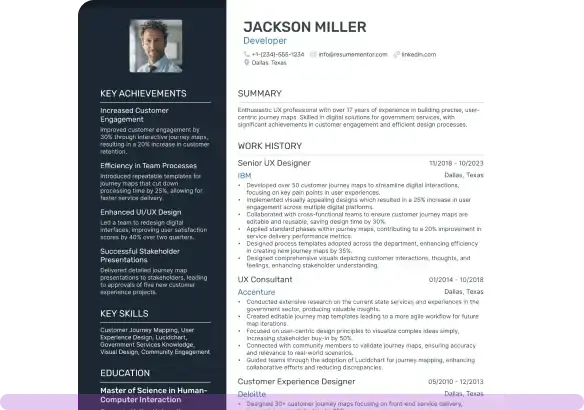Construction Worker Resume Examples

Mar 25, 2025
|
12 min read
Nail your construction worker resume with these solid steps to build a strong foundation for your career. Discover techniques that lay the groundwork for showcasing your skills and experience, ensuring you stand tall in the job market.
Rated by 348 people
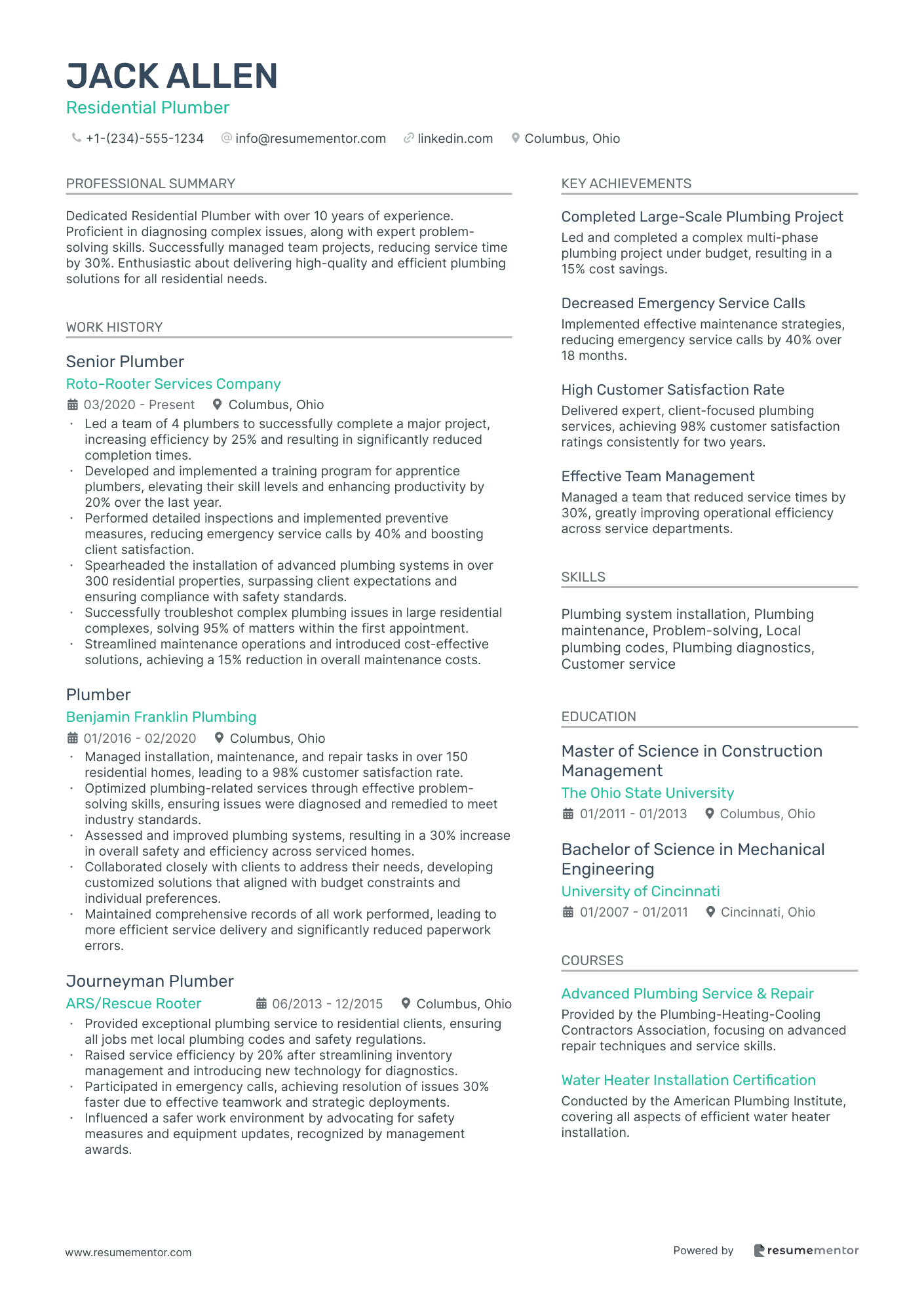
Residential Plumber
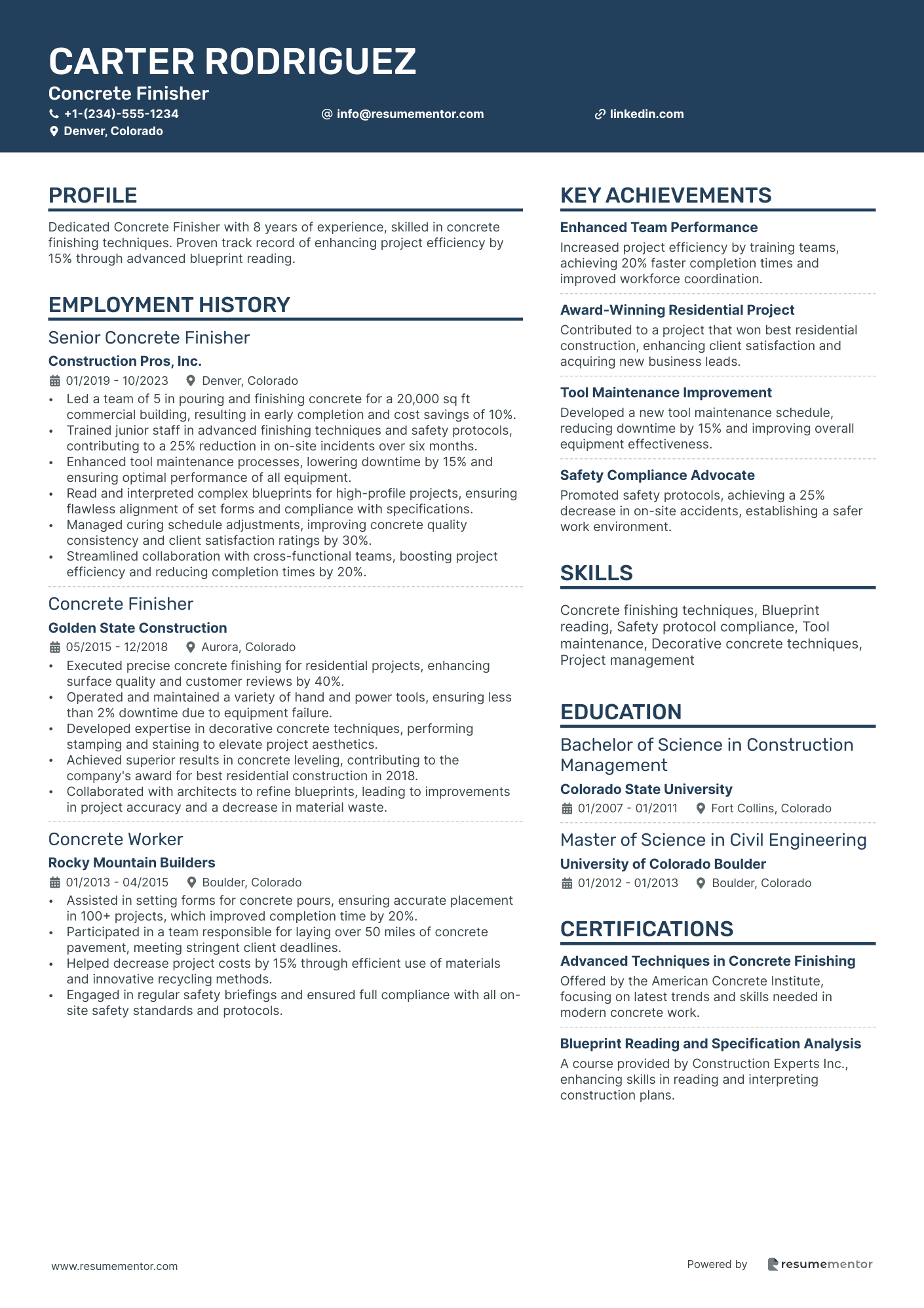
Concrete Finisher
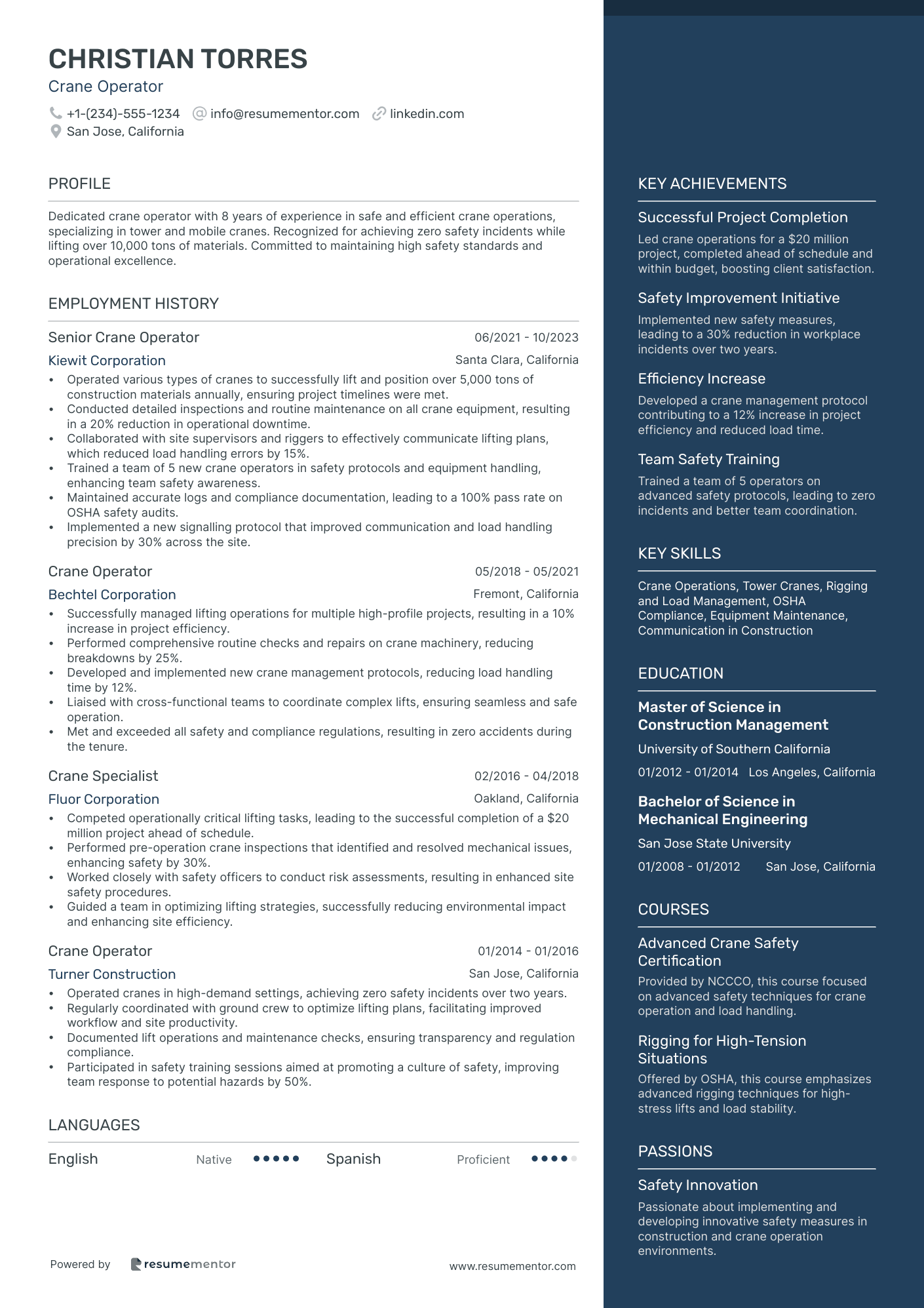
Crane Operator
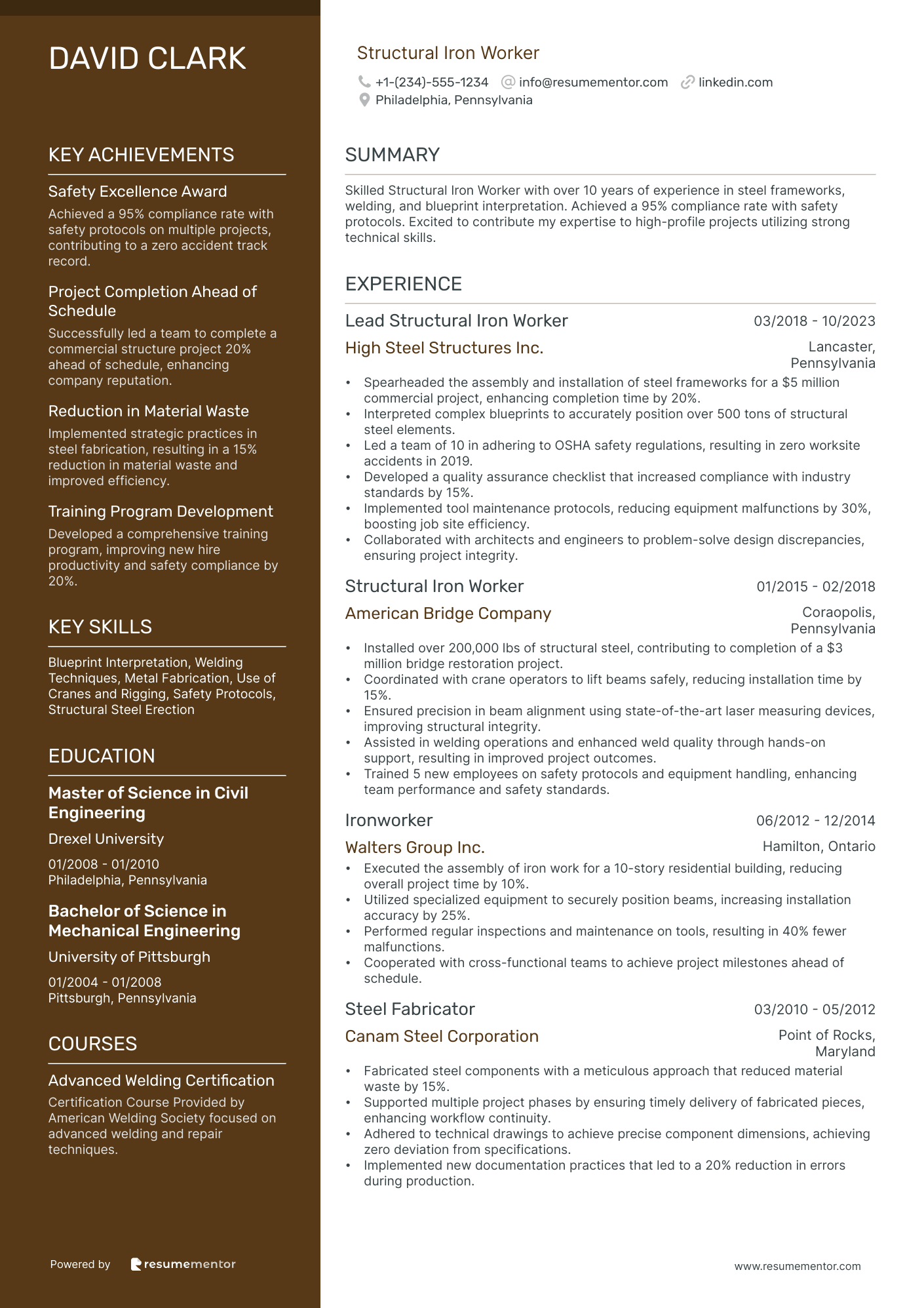
Structural Iron Worker
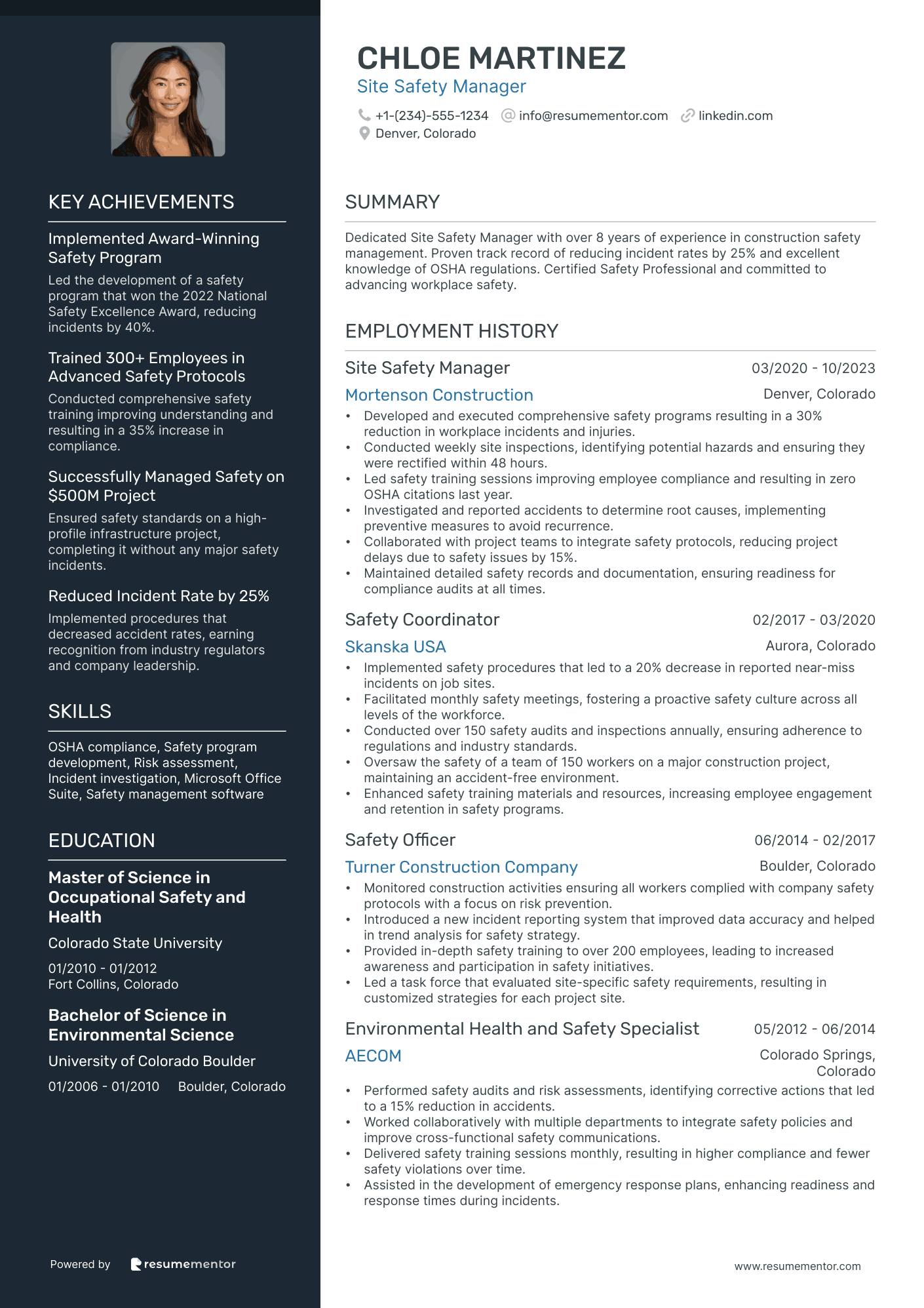
Site Safety Manager
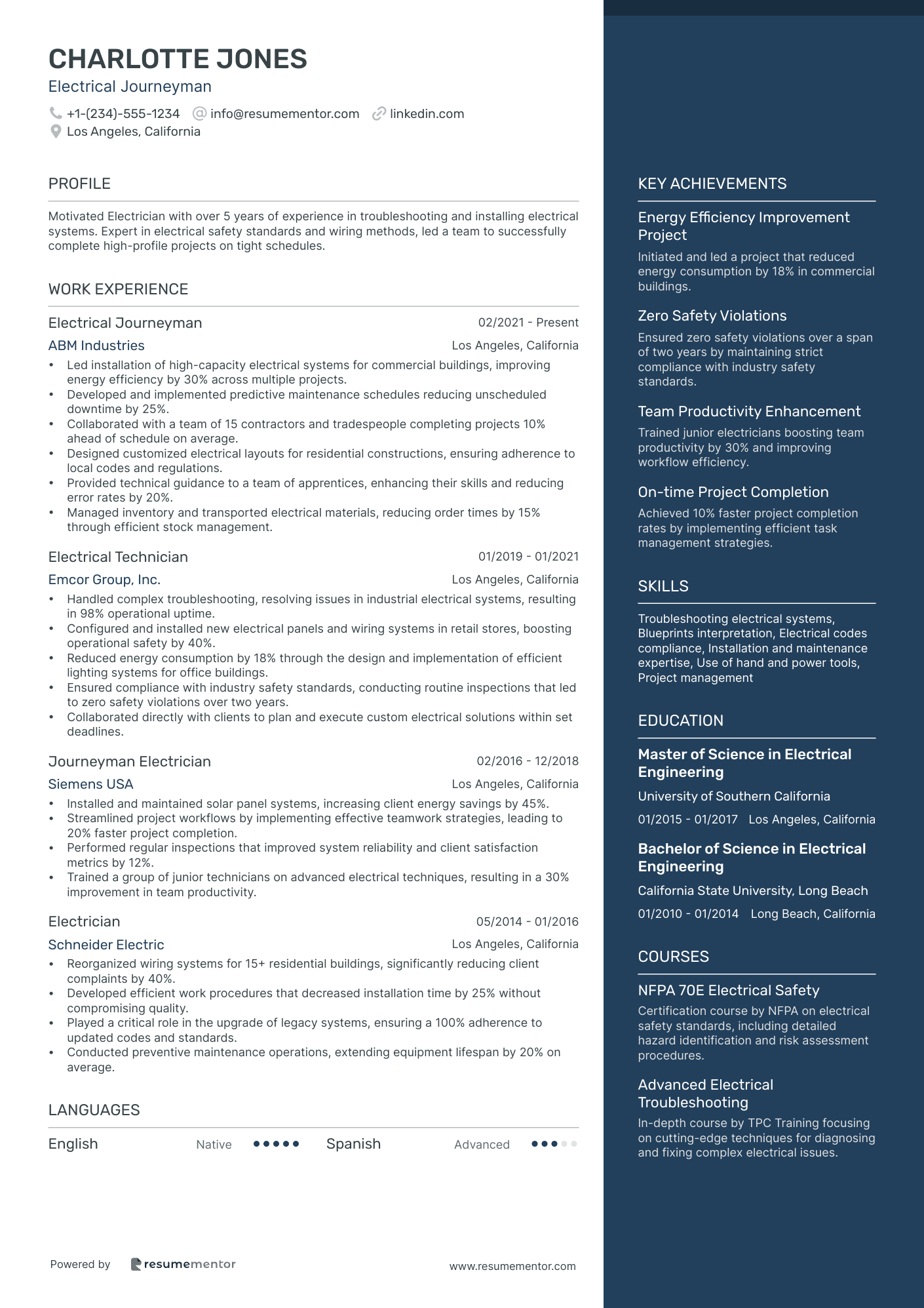
Electrical Journeyman
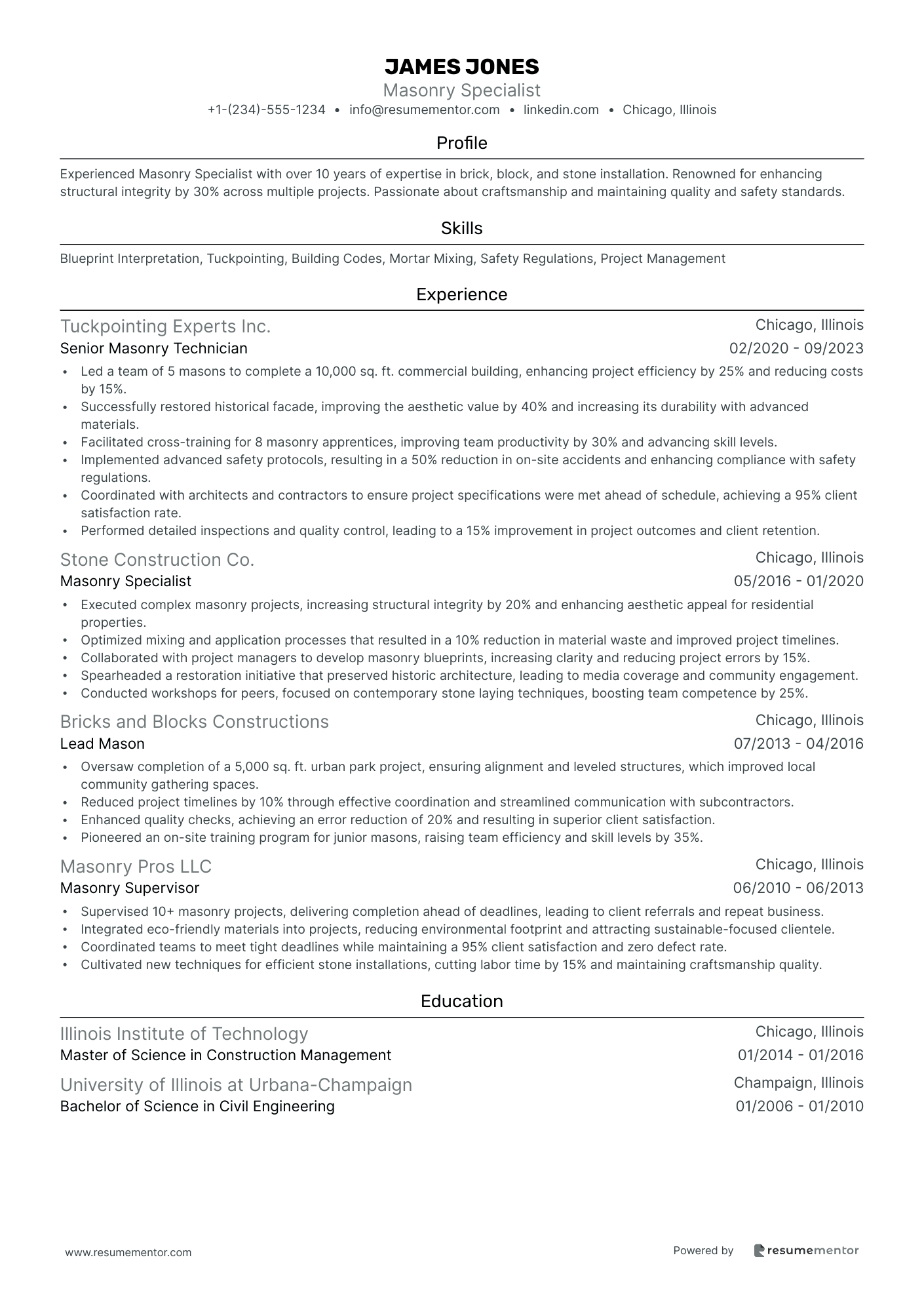
Masonry Specialist
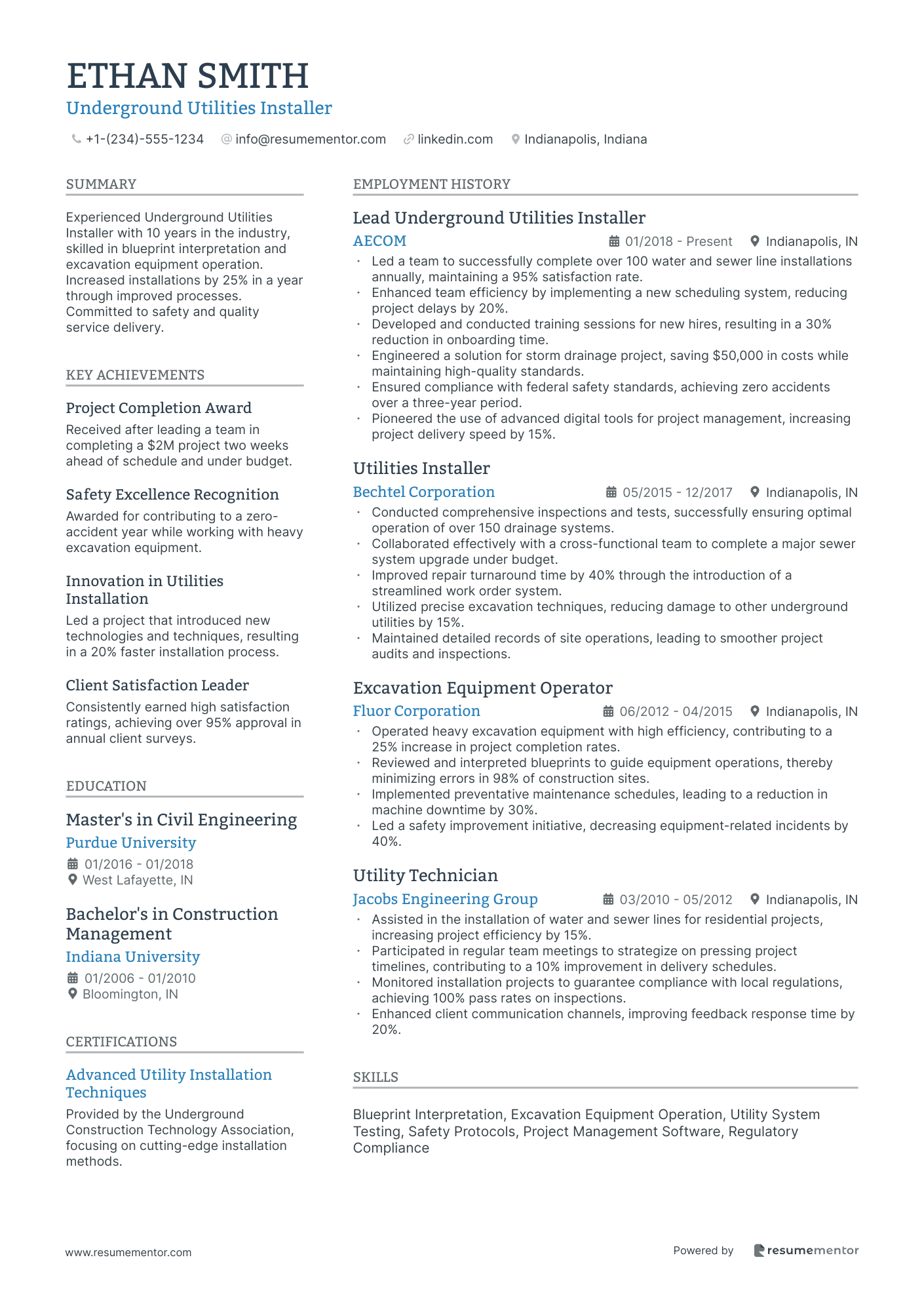
Underground Utilities Installer

Carpentry Foreman

Residential Plumber resume sample
- •Led a team of 4 plumbers to successfully complete a major project, increasing efficiency by 25% and resulting in significantly reduced completion times.
- •Developed and implemented a training program for apprentice plumbers, elevating their skill levels and enhancing productivity by 20% over the last year.
- •Performed detailed inspections and implemented preventive measures, reducing emergency service calls by 40% and boosting client satisfaction.
- •Spearheaded the installation of advanced plumbing systems in over 300 residential properties, surpassing client expectations and ensuring compliance with safety standards.
- •Successfully troubleshot complex plumbing issues in large residential complexes, solving 95% of matters within the first appointment.
- •Streamlined maintenance operations and introduced cost-effective solutions, achieving a 15% reduction in overall maintenance costs.
- •Managed installation, maintenance, and repair tasks in over 150 residential homes, leading to a 98% customer satisfaction rate.
- •Optimized plumbing-related services through effective problem-solving skills, ensuring issues were diagnosed and remedied to meet industry standards.
- •Assessed and improved plumbing systems, resulting in a 30% increase in overall safety and efficiency across serviced homes.
- •Collaborated closely with clients to address their needs, developing customized solutions that aligned with budget constraints and individual preferences.
- •Maintained comprehensive records of all work performed, leading to more efficient service delivery and significantly reduced paperwork errors.
- •Provided exceptional plumbing service to residential clients, ensuring all jobs met local plumbing codes and safety regulations.
- •Raised service efficiency by 20% after streamlining inventory management and introducing new technology for diagnostics.
- •Participated in emergency calls, achieving resolution of issues 30% faster due to effective teamwork and strategic deployments.
- •Influenced a safer work environment by advocating for safety measures and equipment updates, recognized by management awards.
- •Assisted senior plumbers with installations, repairs, and maintenance, learning hands-on skills and applying knowledge to real-world situations.
- •Contributed to a project that upgraded plumbing systems in a 50-apartment complex, completing assignments on schedule.
- •Collaborated with team members effectively, resulting in the successful resolution of 95% of plumbing issues called in.
- •Participated in routine inspections, helping maintain 100% compliance with local codes and enhancing the company's reputation.
Concrete Finisher resume sample
- •Led a team of 5 in pouring and finishing concrete for a 20,000 sq ft commercial building, resulting in early completion and cost savings of 10%.
- •Trained junior staff in advanced finishing techniques and safety protocols, contributing to a 25% reduction in on-site incidents over six months.
- •Enhanced tool maintenance processes, lowering downtime by 15% and ensuring optimal performance of all equipment.
- •Read and interpreted complex blueprints for high-profile projects, ensuring flawless alignment of set forms and compliance with specifications.
- •Managed curing schedule adjustments, improving concrete quality consistency and client satisfaction ratings by 30%.
- •Streamlined collaboration with cross-functional teams, boosting project efficiency and reducing completion times by 20%.
- •Executed precise concrete finishing for residential projects, enhancing surface quality and customer reviews by 40%.
- •Operated and maintained a variety of hand and power tools, ensuring less than 2% downtime due to equipment failure.
- •Developed expertise in decorative concrete techniques, performing stamping and staining to elevate project aesthetics.
- •Achieved superior results in concrete leveling, contributing to the company's award for best residential construction in 2018.
- •Collaborated with architects to refine blueprints, leading to improvements in project accuracy and a decrease in material waste.
- •Assisted in setting forms for concrete pours, ensuring accurate placement in 100+ projects, which improved completion time by 20%.
- •Participated in a team responsible for laying over 50 miles of concrete pavement, meeting stringent client deadlines.
- •Helped decrease project costs by 15% through efficient use of materials and innovative recycling methods.
- •Engaged in regular safety briefings and ensured full compliance with all on-site safety standards and protocols.
- •Contributed to groundwork preparation and infrastructure projects, ensuring surface readiness for concrete pours, which increased the efficiency of subsequent tasks by 30%.
- •Collaborated in a team-oriented environment, leading to improved productivity and project turnaround times.
- •Performed regular maintenance checks on tools and equipment, enhancing operational reliability.
- •Committed to following detailed safety practices, reducing incidents and improving overall site safety.
Crane Operator resume sample
- •Operated various types of cranes to successfully lift and position over 5,000 tons of construction materials annually, ensuring project timelines were met.
- •Conducted detailed inspections and routine maintenance on all crane equipment, resulting in a 20% reduction in operational downtime.
- •Collaborated with site supervisors and riggers to effectively communicate lifting plans, which reduced load handling errors by 15%.
- •Trained a team of 5 new crane operators in safety protocols and equipment handling, enhancing team safety awareness.
- •Maintained accurate logs and compliance documentation, leading to a 100% pass rate on OSHA safety audits.
- •Implemented a new signalling protocol that improved communication and load handling precision by 30% across the site.
- •Successfully managed lifting operations for multiple high-profile projects, resulting in a 10% increase in project efficiency.
- •Performed comprehensive routine checks and repairs on crane machinery, reducing breakdowns by 25%.
- •Developed and implemented new crane management protocols, reducing load handling time by 12%.
- •Liaised with cross-functional teams to coordinate complex lifts, ensuring seamless and safe operation.
- •Met and exceeded all safety and compliance regulations, resulting in zero accidents during the tenure.
- •Competed operationally critical lifting tasks, leading to the successful completion of a $20 million project ahead of schedule.
- •Performed pre-operation crane inspections that identified and resolved mechanical issues, enhancing safety by 30%.
- •Worked closely with safety officers to conduct risk assessments, resulting in enhanced site safety procedures.
- •Guided a team in optimizing lifting strategies, successfully reducing environmental impact and enhancing site efficiency.
- •Operated cranes in high-demand settings, achieving zero safety incidents over two years.
- •Regularly coordinated with ground crew to optimize lifting plans, facilitating improved workflow and site productivity.
- •Documented lift operations and maintenance checks, ensuring transparency and regulation compliance.
- •Participated in safety training sessions aimed at promoting a culture of safety, improving team response to potential hazards by 50%.
Structural Iron Worker resume sample
- •Spearheaded the assembly and installation of steel frameworks for a $5 million commercial project, enhancing completion time by 20%.
- •Interpreted complex blueprints to accurately position over 500 tons of structural steel elements.
- •Led a team of 10 in adhering to OSHA safety regulations, resulting in zero worksite accidents in 2019.
- •Developed a quality assurance checklist that increased compliance with industry standards by 15%.
- •Implemented tool maintenance protocols, reducing equipment malfunctions by 30%, boosting job site efficiency.
- •Collaborated with architects and engineers to problem-solve design discrepancies, ensuring project integrity.
- •Installed over 200,000 lbs of structural steel, contributing to completion of a $3 million bridge restoration project.
- •Coordinated with crane operators to lift beams safely, reducing installation time by 15%.
- •Ensured precision in beam alignment using state-of-the-art laser measuring devices, improving structural integrity.
- •Assisted in welding operations and enhanced weld quality through hands-on support, resulting in improved project outcomes.
- •Trained 5 new employees on safety protocols and equipment handling, enhancing team performance and safety standards.
- •Executed the assembly of iron work for a 10-story residential building, reducing overall project time by 10%.
- •Utilized specialized equipment to securely position beams, increasing installation accuracy by 25%.
- •Performed regular inspections and maintenance on tools, resulting in 40% fewer malfunctions.
- •Cooperated with cross-functional teams to achieve project milestones ahead of schedule.
- •Fabricated steel components with a meticulous approach that reduced material waste by 15%.
- •Supported multiple project phases by ensuring timely delivery of fabricated pieces, enhancing workflow continuity.
- •Adhered to technical drawings to achieve precise component dimensions, achieving zero deviation from specifications.
- •Implemented new documentation practices that led to a 20% reduction in errors during production.
Site Safety Manager resume sample
- •Developed and executed comprehensive safety programs resulting in a 30% reduction in workplace incidents and injuries.
- •Conducted weekly site inspections, identifying potential hazards and ensuring they were rectified within 48 hours.
- •Led safety training sessions improving employee compliance and resulting in zero OSHA citations last year.
- •Investigated and reported accidents to determine root causes, implementing preventive measures to avoid recurrence.
- •Collaborated with project teams to integrate safety protocols, reducing project delays due to safety issues by 15%.
- •Maintained detailed safety records and documentation, ensuring readiness for compliance audits at all times.
- •Implemented safety procedures that led to a 20% decrease in reported near-miss incidents on job sites.
- •Facilitated monthly safety meetings, fostering a proactive safety culture across all levels of the workforce.
- •Conducted over 150 safety audits and inspections annually, ensuring adherence to regulations and industry standards.
- •Oversaw the safety of a team of 150 workers on a major construction project, maintaining an accident-free environment.
- •Enhanced safety training materials and resources, increasing employee engagement and retention in safety programs.
- •Monitored construction activities ensuring all workers complied with company safety protocols with a focus on risk prevention.
- •Introduced a new incident reporting system that improved data accuracy and helped in trend analysis for safety strategy.
- •Provided in-depth safety training to over 200 employees, leading to increased awareness and participation in safety initiatives.
- •Led a task force that evaluated site-specific safety requirements, resulting in customized strategies for each project site.
- •Performed safety audits and risk assessments, identifying corrective actions that led to a 15% reduction in accidents.
- •Worked collaboratively with multiple departments to integrate safety policies and improve cross-functional safety communications.
- •Delivered safety training sessions monthly, resulting in higher compliance and fewer safety violations over time.
- •Assisted in the development of emergency response plans, enhancing readiness and response times during incidents.
Electrical Journeyman resume sample
- •Led installation of high-capacity electrical systems for commercial buildings, improving energy efficiency by 30% across multiple projects.
- •Developed and implemented predictive maintenance schedules reducing unscheduled downtime by 25%.
- •Collaborated with a team of 15 contractors and tradespeople completing projects 10% ahead of schedule on average.
- •Designed customized electrical layouts for residential constructions, ensuring adherence to local codes and regulations.
- •Provided technical guidance to a team of apprentices, enhancing their skills and reducing error rates by 20%.
- •Managed inventory and transported electrical materials, reducing order times by 15% through efficient stock management.
- •Handled complex troubleshooting, resolving issues in industrial electrical systems, resulting in 98% operational uptime.
- •Configured and installed new electrical panels and wiring systems in retail stores, boosting operational safety by 40%.
- •Reduced energy consumption by 18% through the design and implementation of efficient lighting systems for office buildings.
- •Ensured compliance with industry safety standards, conducting routine inspections that led to zero safety violations over two years.
- •Collaborated directly with clients to plan and execute custom electrical solutions within set deadlines.
- •Installed and maintained solar panel systems, increasing client energy savings by 45%.
- •Streamlined project workflows by implementing effective teamwork strategies, leading to 20% faster project completion.
- •Performed regular inspections that improved system reliability and client satisfaction metrics by 12%.
- •Trained a group of junior technicians on advanced electrical techniques, resulting in a 30% improvement in team productivity.
- •Reorganized wiring systems for 15+ residential buildings, significantly reducing client complaints by 40%.
- •Developed efficient work procedures that decreased installation time by 25% without compromising quality.
- •Played a critical role in the upgrade of legacy systems, ensuring a 100% adherence to updated codes and standards.
- •Conducted preventive maintenance operations, extending equipment lifespan by 20% on average.
Masonry Specialist resume sample
- •Led a team of 5 masons to complete a 10,000 sq. ft. commercial building, enhancing project efficiency by 25% and reducing costs by 15%.
- •Successfully restored historical facade, improving the aesthetic value by 40% and increasing its durability with advanced materials.
- •Facilitated cross-training for 8 masonry apprentices, improving team productivity by 30% and advancing skill levels.
- •Implemented advanced safety protocols, resulting in a 50% reduction in on-site accidents and enhancing compliance with safety regulations.
- •Coordinated with architects and contractors to ensure project specifications were met ahead of schedule, achieving a 95% client satisfaction rate.
- •Performed detailed inspections and quality control, leading to a 15% improvement in project outcomes and client retention.
- •Executed complex masonry projects, increasing structural integrity by 20% and enhancing aesthetic appeal for residential properties.
- •Optimized mixing and application processes that resulted in a 10% reduction in material waste and improved project timelines.
- •Collaborated with project managers to develop masonry blueprints, increasing clarity and reducing project errors by 15%.
- •Spearheaded a restoration initiative that preserved historic architecture, leading to media coverage and community engagement.
- •Conducted workshops for peers, focused on contemporary stone laying techniques, boosting team competence by 25%.
- •Oversaw completion of a 5,000 sq. ft. urban park project, ensuring alignment and leveled structures, which improved local community gathering spaces.
- •Reduced project timelines by 10% through effective coordination and streamlined communication with subcontractors.
- •Enhanced quality checks, achieving an error reduction of 20% and resulting in superior client satisfaction.
- •Pioneered an on-site training program for junior masons, raising team efficiency and skill levels by 35%.
- •Supervised 10+ masonry projects, delivering completion ahead of deadlines, leading to client referrals and repeat business.
- •Integrated eco-friendly materials into projects, reducing environmental footprint and attracting sustainable-focused clientele.
- •Coordinated teams to meet tight deadlines while maintaining a 95% client satisfaction and zero defect rate.
- •Cultivated new techniques for efficient stone installations, cutting labor time by 15% and maintaining craftsmanship quality.
Underground Utilities Installer resume sample
- •Led a team to successfully complete over 100 water and sewer line installations annually, maintaining a 95% satisfaction rate.
- •Enhanced team efficiency by implementing a new scheduling system, reducing project delays by 20%.
- •Developed and conducted training sessions for new hires, resulting in a 30% reduction in onboarding time.
- •Engineered a solution for storm drainage project, saving $50,000 in costs while maintaining high-quality standards.
- •Ensured compliance with federal safety standards, achieving zero accidents over a three-year period.
- •Pioneered the use of advanced digital tools for project management, increasing project delivery speed by 15%.
- •Conducted comprehensive inspections and tests, successfully ensuring optimal operation of over 150 drainage systems.
- •Collaborated effectively with a cross-functional team to complete a major sewer system upgrade under budget.
- •Improved repair turnaround time by 40% through the introduction of a streamlined work order system.
- •Utilized precise excavation techniques, reducing damage to other underground utilities by 15%.
- •Maintained detailed records of site operations, leading to smoother project audits and inspections.
- •Operated heavy excavation equipment with high efficiency, contributing to a 25% increase in project completion rates.
- •Reviewed and interpreted blueprints to guide equipment operations, thereby minimizing errors in 98% of construction sites.
- •Implemented preventative maintenance schedules, leading to a reduction in machine downtime by 30%.
- •Led a safety improvement initiative, decreasing equipment-related incidents by 40%.
- •Assisted in the installation of water and sewer lines for residential projects, increasing project efficiency by 15%.
- •Participated in regular team meetings to strategize on pressing project timelines, contributing to a 10% improvement in delivery schedules.
- •Monitored installation projects to guarantee compliance with local regulations, achieving 100% pass rates on inspections.
- •Enhanced client communication channels, improving feedback response time by 20%.
Carpentry Foreman resume sample
- •Led a team of 15 carpenters in a project worth $2 million, resulting in completing 2 weeks ahead of schedule by optimizing resources.
- •Conducted safety drills quarterly, reducing on-site accidents by 20% and improving overall safety standards.
- •Managed material orders and maintained inventory accuracy, cutting down delays in procurement by 30%.
- •Interpreted complex blueprints and improved project accuracy, increasing client satisfaction by 15%.
- •Established and maintained positive relationships with clients and stakeholders, receiving repeat contracts worth $1 million.
- •Implemented updated carpentry techniques, reducing waste by 10% and supporting green building practices.
- •Supervised a team of 10 carpenters, achieving project milestones consistently and improving team productivity by 25%.
- •Initiated workshop sessions for apprentices, enhancing their technical skills and readiness for advanced tasks.
- •Monitored project budgets closely, leading to savings of $50,000 across multiple projects.
- •Collaborated with architects and engineers in project planning phases, ensuring smooth project execution and design fidelity.
- •Oversaw the implementation of new carpentry technologies, boosting project efficiency by 20%.
- •Constructed and installed structural frameworks with precision, contributing to the on-time completion of $500k projects.
- •Participated in safety training programs, which helped reduce accidents in the work area by 15%.
- •Improved product quality by adopting innovative carpentry techniques, leading to a 20% increase in client recommendations.
- •Enhanced material usage strategies, saving about 10% on project costs.
- •Assisted senior carpenters in constructing detailed frameworks, aiding in successful project completions.
- •Maintained tools and equipment, ensuring work readiness and efficiency.
- •Gained hands-on experience in blueprint reading and material selection, reducing beginner errors by 40%.
- •Contributed to team efforts in complying with safety standards, which resulted in a 100% compliance record.
As a construction worker, your resume serves as the blueprint of your career journey. While crafting it can feel like building a bridge without plans, it's essential for connecting your on-site skills to future opportunities. Translating your hands-on expertise into words can be challenging, as the dependable and hardworking traits you develop often resist easy expression on paper.
Yet, a strong resume is your key to unlocking new opportunities. It can clearly highlight your skills, from operating heavy machinery to managing teams and ensuring quality standards on-site. This is where employers can see your skills and dedication come to life.
To make the process smoother, start with a resume template. A solid template offers the structure needed to showcase your experience and skills effectively, helping you stand out in a detail-oriented field.
By using a well-structured template, you capture your years of hard work and construction knowledge in a way that's compelling to employers. Although construction is a hands-on field, your resume serves as the bridge between your talents and potential job offers. Like any reliable construction project, it all begins with a solid foundation.
Key Takeaways
- Crafting an effective resume for a construction worker involves translating practical on-site skills into clear, structured formats to connect past experiences with future job opportunities.
- A construction worker's resume should clearly communicate skills in areas like machinery operation, safety compliance, and project management, using quantifiable achievements to demonstrate value.
- Creating a functional, visually appealing resume using clean fonts and ensuring it is saved as a PDF helps maintain formatting consistency and clarity across various devices.
- Incorporating a skills section with both hard (e.g., blueprint reading, machinery operation) and soft skills (e.g., communication, teamwork) aligns your resume with what employers and applicant tracking systems are looking for.
- Additional resume sections such as certifications, education, and volunteer work enhance your profile by showing a commitment to ongoing learning and community engagement.
What to focus on when writing your construction worker resume
A construction worker resume should effectively communicate your practical experience and understanding of construction tasks to the recruiter. Start by highlighting your skills and dedication to safety, which are crucial to showcasing your readiness for the job. Organize your information clearly so recruiters can quickly see why you’re a great fit.
How to structure your construction worker resume
- Contact Information — Keep your full name, phone number, email address, and location at the top where it's easy to find. Prioritize a professional email address that reflects your name, ensuring your details are quickly accessible when potential employers need them. This straightforward approach sets the foundation for a well-organized resume.
- Objective Statement — Write a concise sentence focused on your construction expertise and future career aspirations, highlighting teamwork and safety. This section should reflect your enthusiasm for the role, offering a glimpse into your professional drive. It sets the tone for the rest of the document, providing context for your experiences and skills.
- Work Experience — Describe the construction projects you’ve been part of, your roles, and specific achievements. Use action-oriented language to vividly portray your contributions, such as enhancing efficiency or problem-solving on a construction site. Including metrics or clear outcomes like "improved worksite safety by 20%" can illustrate your impact effectively. These experiences build a narrative that leads smoothly into showcasing your specific abilities.
- Skills — Emphasize your capabilities in using power tools, blueprint reading, and adherence to OSHA standards, which are essential in construction. Mentioning specialized skills like welding or masonry demonstrates adaptability and competency in various tasks, ensuring you're well-prepared for different job requirements. These skills closely tie into the certifications you may hold.
- Certifications — List your certifications, like OSHA 10 or 30, First Aid/CPR, or relevant trade licenses, underscoring your commitment to maintaining a safe work environment. These credentials validate your expertise and willingness to go beyond the basics, reassuring recruiters of your dedication to professional growth. This leads naturally to discussing your educational background.
- Education — Mention your highest level of education or vocational training, detailing any trade school courses that provided specialized skills. This foundation supports your work experience and skills, showing a broader commitment to learning and improvement. Your education links the practical experience with your range of qualifications.
Below, we’ll cover each resume section more in-depth to help you craft a document that captures the essence of your professional story in the construction field.
Which resume format to choose
Creating a resume for a construction worker position can be straightforward with the right approach. Start by using a functional format. This format is especially helpful in the construction industry because it highlights the skills and hands-on experience that are crucial to your role, allowing potential employers to see what you’re capable of rather than just where you’ve worked.
When it comes to fonts, select ones that are clean and modern to ensure your resume is readable and visually appealing. Rubik, Lato, and Oswald are excellent choices. They provide a contemporary look that helps your resume stand out without being too flashy, making it easier for hiring managers to focus on the content.
Saving your resume as a PDF is essential, as it keeps your formatting consistent and ensures your resume opens correctly on any device. This is particularly important in the construction field, where documents may be viewed on various devices, from computers in the office to tablets on-site.
Setting your margins to about one inch on each side is key to achieving a well-organized layout. This spacing creates a clean design and enough white space to make your resume easy to read at a glance. The organized appearance can greatly enhance the way your experience and skills are perceived, helping you make a strong impression in your job search.
How to write a quantifiable resume experience section
Your construction worker resume experience section should focus on clear, quantifiable achievements that align with the job ad you’re targeting. Begin by listing your most recent position and work backwards, covering about 10–15 years of relevant experience. Choose job titles that highlight your skills and career growth. Tailoring each resume to match the job ad is crucial. Emphasize your accomplishments using action words like "constructed," "managed," "operated," or "implemented."
Here's an example of a construction worker resume experience section:
- •Supervised a team of 15 workers on a $2.5 million high-rise project, completing it 10% under budget.
- •Enhanced team safety measures, resulting in a 30% reduction in workplace incidents within one year.
- •Streamlined project workflows to speed up construction by 20%, leading to earlier project completions.
- •Trained 10 junior employees who advanced to senior roles within two years.
This experience section effectively communicates your value by focusing on measurable achievements that resonate with the job requirements. The use of strong action-oriented language draws attention to your impactful contributions, such as completing projects under budget and reducing workplace incidents. These quantifiable results clearly demonstrate your competence and the benefits you've brought to previous employers, making you a compelling candidate.
Furthermore, the section is strategically structured to highlight a relevant timeframe of experience, presenting a clear narrative of a seasoned, yet focused career. By immediately showcasing your key achievements, it ensures your strengths capture the hiring manager's attention and align with the construction industry’s expectations. Tailored details within the description seamlessly reinforce your readiness for future roles, making a lasting impression.
Problem-Solving Focused resume experience section
A problem-solving focused construction worker's resume experience section should clearly demonstrate your ability to overcome challenges and deliver effective solutions. Start by reflecting on past projects to identify instances where you successfully navigated obstacles. Use straightforward, result-oriented sentences to convey your impact, highlighting the tools and methods that led to noticeable improvements in your work. It's crucial to maintain an active voice and keep your language simple, avoiding jargon that may confuse potential employers.
When drafting your bullet points, strive for clarity and seamless connection between topics. Begin each with an action verb that underscores your initiative and problem-solving ability, smoothly linking each achievement to the next. Describe specific accomplishments, emphasizing how they contributed to project success. Quantifying these achievements whenever possible will give employers a clear picture of your effectiveness, showing them how you can bring value through your proven problem-solving skills.
Construction Worker
ABC Construction Co.
June 2020 - Present
- Identified structural issues in a 10-apartment complex, boosting safety and ensuring compliance with regulations.
- Created a new scheduling system that cut repair time by 20%, enhancing overall project effectiveness through better planning.
- Partnered with team members to launch a recycling program, leading to a 15% reduction in material waste and showcasing environmental responsibility.
- Modified construction techniques to handle weather-related disruptions, consistently meeting deadlines and maintaining project momentum.
Project-Focused resume experience section
A project-focused construction worker resume experience section should effectively highlight your role in various projects while showcasing your skills and achievements. Start by listing each project where you played a significant part, focusing on your responsibilities and contributions. Use engaging language to weave a narrative that makes your achievements stand out. Break your contributions into bullet points that clearly illustrate your impact, and whenever possible, use numbers or data to show concrete results, such as how you managed to stay within budgets or meet deadlines.
By emphasizing your problem-solving abilities and teamwork skills, you can demonstrate your value to potential employers. Explain how you ensured safety standards were met, managed resources efficiently, or improved work processes. Tailoring your resume to align with the job you're targeting allows you to show how your experience sets you apart as an exceptional candidate. Each project example should connect back to these themes, highlighting a well-rounded set of skills that make you an asset in the construction industry.
Construction Supervisor
January 2022 - September 2023
- Led a team of five workers to complete renovations on a historic building, ensuring all work met high safety and quality standards.
- Managed resources effectively, reducing project expenses by 10% while maintaining the project timeline.
- Improved workflow processes by implementing a new scheduling system, which increased team productivity by 15%.
- Collaborated with architects and engineers to resolve structural challenges, ensuring project success.
Efficiency-Focused resume experience section
An efficiency-focused construction worker resume experience section should effectively highlight the achievements that demonstrate your ability to boost productivity. Begin by identifying specific projects or tasks where you made a notable impact. Showcasing how your skills directly contributed to better results creates a compelling narrative. Using simple and clear language, detail your efforts and their outcomes, and quantify your achievements—like completing tasks faster or enhancing work quality—to add concrete value to your claims.
To present your accomplishments clearly, organize them with bullet points that emphasize problem-solving, teamwork, and task execution. By including details such as the type of work, your job title, and the workplace, you provide essential context that helps employers quickly grasp your qualifications. This structured approach ensures that your strengths stand out and makes it easy for employers to envision the positive impact you could have on their team. Clarity and conciseness are key, as employers value candidates who communicate effectively and deliver strong results.
Lead Construction Worker
ABC Residential Builders
June 2020 - September 2023
- Managed a team of 5 workers to finish tasks 2 weeks early, speeding up the project timeline by 20%.
- Set up a new system for organizing tools and materials, cutting down time spent searching for equipment by 30%.
- Worked with engineers to solve structural problems, keeping safety and quality intact without delaying the project.
- Helped train two new team members, which boosted team productivity by 15% in the first month.
Achievement-Focused resume experience section
A construction-focused resume experience section should highlight the achievements and key contributions you made at each job site. Start by identifying your essential duties and detail how you effectively carried them out. Draw attention to the specific projects you finished, the skills you honed, and any recognition you received. Using strong action verbs like 'achieved,' 'improved,' or 'completed' will showcase your impact, helping potential employers appreciate the value you bring to their team.
Each bullet point should clearly describe a responsibility or accomplishment, supported by measurable results such as cost reduction or efficiency improvements. For instance, if you finished a project ahead of schedule or implemented a system that enhanced safety, include those details. Quantifying your achievements with numbers or percentages will make your resume stand out and provide potential employers with a vivid picture of your capabilities.
Senior Construction Worker
ABC Construction Co.
June 2018 - Present
- Led a team of 10 workers in building residential homes, completing projects 15% under budget through effective resource management.
- Introduced a new safety protocol checklist, reducing on-site accidents by 20%.
- Trained new hires on equipment operation, boosting team productivity by 25%.
- Coordinated with contractors and suppliers to ensure timely project completion, maintaining an impressive 98% on-time delivery rate.
Write your construction worker resume summary section
A skills-focused construction worker resume summary should quickly capture your expertise and strengths in the industry. It's all about painting a snapshot of who you are as a professional. For instance, consider the following example:
In this example, you can see how it packs a punch by clearly stating years of experience alongside specific skills. Talking about abilities like blueprint reading and safety compliance paints a picture of your technical expertise. Mentioning teamwork and deadline management further builds on the idea that you're not only skilled but also dependable. This approach draws in an employer by spotlighting why you’re a valuable hire.
Distinguishing this from other parts of the resume, like objectives or profiles, helps clarify your intent. While a resume objective zeroes in on your career goals—ideal for newcomers—a summary extends a broader look into your experience and strengths. Meanwhile, a summary of qualifications lists out achievements and skills more formally. Whatever form you choose, ensure it delivers a compelling view of what you bring to the table, igniting an employer’s interest right from the start.
Listing your construction worker skills on your resume
A skills-focused construction worker resume should effectively highlight your key abilities to prospective employers. You can either list your skills in a dedicated section or weave them into other areas, such as your experience or summary. By doing this, you can show both your strengths and soft skills, highlighting your ability to work well with others and adapt to varying situations. Hard skills, like operating machinery or understanding building codes, are specific, teachable abilities you've gained through training or on the job.
Incorporating these skills as keywords in your resume isn't just about listing capabilities. It's also about aligning with what employers and applicant tracking systems are searching for. By matching your skills with job descriptions, you significantly elevate your chances of securing an interview.
Consider this example for a standalone skills section on your resume:
This skills section is effective because it clearly outlines the competencies critical for construction workers. Each skill not only demonstrates a well-rounded candidate but also ensures that your resume resonates with what employers are actively looking for, helping you stand out.
Best hard skills to feature on your construction worker resume
To be effective in construction, you need a broad set of hard skills that demonstrate your technical proficiency. These skills should highlight your ability to handle tools, operate equipment, and understand building systems, as well as your knowledge of safety and structural guidelines.
Hard Skills
- Blueprint Reading
- Machinery Operation
- Concrete Pouring and Finishing
- Carpentry
- Electrical Systems Knowledge
- Plumbing Installation and Repair
- Welding
- Masonry Work
- Roofing
- HVAC Systems
- Safety Protocols Understanding
- Construction Estimation
- Heavy Equipment Handling
- Framing Techniques
- Demolition Skills
Best soft skills to feature on your construction worker resume
Equally important are soft skills, which illustrate your capacity to collaborate with others and adapt to different work environments. These skills emphasize your ability to manage relationships and tackle problems effectively in dynamic settings.
Soft Skills
- Communication
- Teamwork
- Problem Solving
- Attention to Detail
- Time Management
- Adaptability
- Reliability
- Leadership
- Strong Work Ethic
- Flexibility
- Initiative
- Conflict Resolution
- Stress Management
- Customer Service
- Creative Thinking
How to include your education on your resume
The education section is a crucial part of your construction worker resume. It highlights your learning and qualifications. Tailor this section to match the job you want. Only include education that is relevant. Unrelated qualifications should be left out. If your GPA is strong, include it. Write it as: "GPA: 3.5/4.0". If you earned cum laude honors, add them after your degree, like "Bachelor of Science in Construction Engineering, Cum Laude". Mention your degree clearly, such as "Associate of Applied Science in Construction Management".
Wrong Example:
Right Example:
The second example is strong because it lists education relevant to a construction worker. It shows a high GPA, which can impress employers. The degree is directly related to construction work, making it more suitable. Keep your education section focused and relevant to boost your resume.
How to include construction worker certificates on your resume
Including a certificates section in your resume is crucial, especially for construction workers, as it showcases your qualifications and skills. You can incorporate certificates in two places: a dedicated section or directly within the header. Listing them in the header immediately grabs the employer's attention. For example, your header might read: "John Doe, Certified OSHA Safety, CPR & First Aid."
To properly include a certificates section, list the name of each certificate clearly. Include the date you obtained the certificate to show its validity. Add the issuing organization to increase credibility.
For a standalone certificates section, consider this example:
This example is effective because it includes industry-relevant certifications like OSHA Safety and CPR & First Aid, which are highly valued in construction work. Clearly naming the certificates and their issuers confirms your expertise and credibility. Being concise yet descriptive helps hiring managers quickly assess your qualifications.
Extra sections to include on your construction worker resume
Creating a compelling resume can make a huge difference in securing your next role as a construction worker. Including diverse sections not only highlights your skills but also adds depth to your profile. Here’s how you can effectively incorporate and benefit from various sections.
- Language section — Showcase any additional languages you speak, like Spanish or French, to highlight your communication abilities with diverse crews.
- Hobbies and interests section — Share interests such as woodworking or DIY projects to illustrate your passion and commitment to the field.
- Volunteer work section — Include any volunteer construction projects or community work to demonstrate your dedication and teamwork skills.
- Books section — List any relevant construction or engineering books you've read to show your commitment to learning and staying informed.
These sections not only enrich your resume but also present you as a well-rounded candidate. They give potential employers a broader picture of your skills and interests beyond basic qualifications. Tailoring each section to match your experiences can showcase the unique qualities you bring to the table. Make sure to be concise and direct in presenting this information. A thoughtfully crafted resume can truly make you stand out.
In Conclusion
In conclusion, creating a strong resume is your road map to success in the construction industry. It's more than just a list of past jobs; it's a tool that translates your hands-on skills into opportunities. Begin by using a well-structured template to organize your experiences and showcase your abilities in a clear manner. Each section, from your contact details to your certifications, plays a crucial role in demonstrating your readiness for new challenges.
Highlight your work experience with quantifiable achievements to show your effectiveness on the job. Employers value clear examples of problem-solving and efficiency improvements, which can set you apart from other candidates. When listing your skills, include both hard and soft skills, ensuring they resonate with what employers are seeking in the job descriptions.
Remember to tailor your resume to the specific job you’re targeting. Doing so shows that you understand the industry's expectations and are a serious contender for the role. Additionally, extra sections like languages spoken, hobbies, and volunteer work can provide a more well-rounded snapshot of who you are, appealing to employers on a personal level.
Your education and certificates also prove your commitment to safety and professional development, adding weight to your qualifications. By presenting your skills and experiences effectively, your resume can bridge the gap between where you are and where you want to be in your construction career. Through careful organization and a focus on achievements and skills, you're more likely to capture the attention of hiring managers and unlock exciting job opportunities.
Related Articles
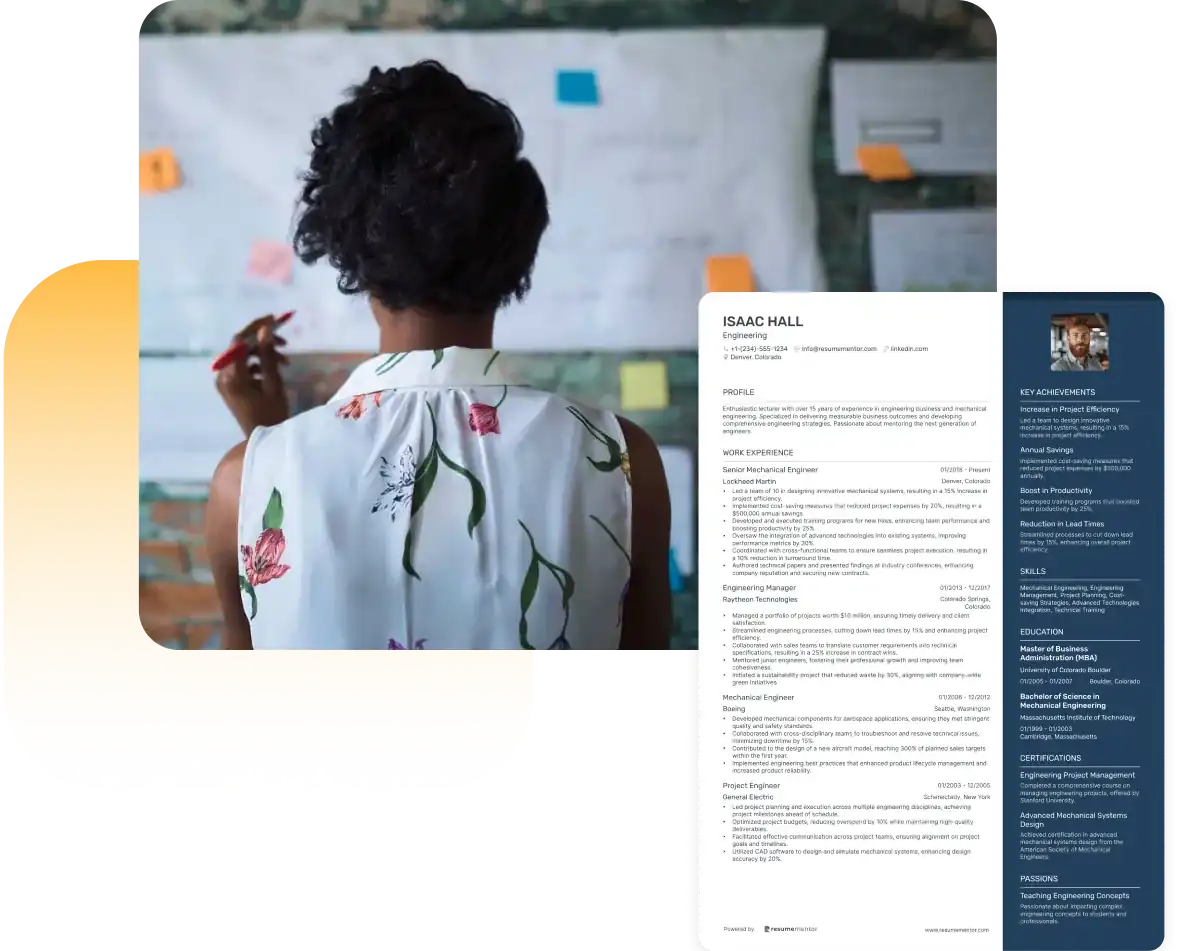
Continue Reading
Check more recommended readings to get the job of your dreams.
Resume
Resources
Tools
© 2025. All rights reserved.
Made with love by people who care.

